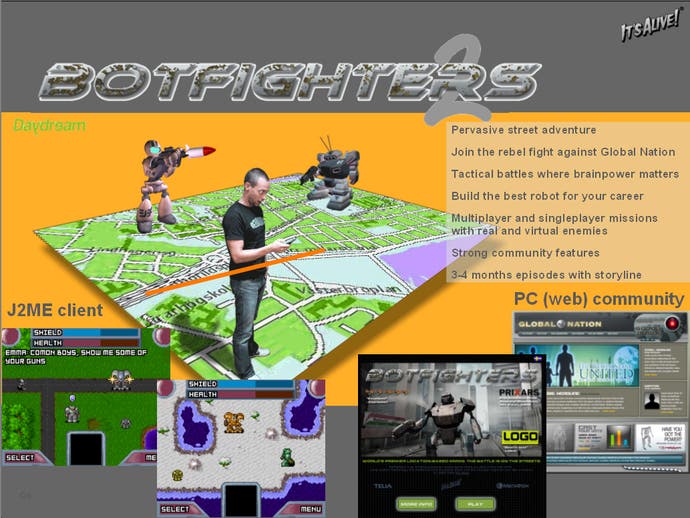Through the looking glass: Keith Stuart on the irresistible rise of augmented reality
Gurdurrs of perception.
Within two decades, possibly sooner, our notion of what constitutes reality is going to completely collapse in on itself like a supermarket own-brand tent at a rainy music festival. Hello, welcome to another article about Pokémon Go.
Bear with me.
Until about 15 years ago you could be fairly certain that almost everyone else you met on the street would be having a broadly similar experience of reality. With the exclusion of recreational drug users and people with certain mental health problems, everyone saw the same things - the same shops, the same houses, the same parks, and the same traffic - as everyone else.
Of course, there would be subtle differences in perception: an architect wandering through your town centre may understand it in a completely different way to, say, an expert in commercial design -the former reading the buildings themselves, the latter recognising and decoding the storefronts, brands and logos. But fundamentally - and to skip out a lot of incredibly complex philosophical ideas about the nature of objectivity (I'm looking at you, Kant!) - we'd all be seeing the same objects; we'd just be interpreting them differently.
But then in 2002 something interesting happened. It's Alive, a small Swedish software developer, produced a game called Botfighters, which used the formative GPS and online functionality in 2G mobile phones, to create a multiplayer, location-based combat experience. It was essentially a city-wide game of cat and mouse played out against an unseen, unknown enemy somewhere in your vicinity. Players crept through the streets, receiving text messages about the whereabouts of their assigned foe, then launched missiles against them. Skilled players formed elite clans to help build points which could be spent on new gear.
Of course, there had been treasure hunt-style games for hundreds of years before this, utilising elements of orienteering and geocaching to turn everyday environments into playful locations. These began infiltrating geek space in the early 70s, when Yale student and graphic designer Donald Luskin began organising The Game, a 48-hour team-based scavenger hunt originally based in LA, but later in San Francisco and Seattle. But what It's Alive did was exploit modern communications technology to massively widen the player base. At its peak, Botfighters attracted tens of thousands of players throughout Sweden, Russia and China. Suddenly the streets of major cities from Stockholm to St Petersburg were filled with people who were seeing their surroundings in a very different way to everyone else.

There have been many, many examples since, from massively multiplayer map-control games like Undercover and Shadow Cities, to paranoid cinematic thrillers like Blast Theory's A Machine To See With, to glorified tourist guides like Four Square and Gowalla. We've also seen the stuttering birth of augmented reality technology, with games that use smart phone, PSP, 3DS and Vita cameras to overlay computer visuals onto the "real world". In 2013 Google soft launched its Glass headset into the tech community, which promised to marry global positioning with AR, but just ended up making a lot of nerdy guys look really sinister. None of these experiences really gained much traction outside of the typical early adopter demographic.
Until now.
With around 50 million players, Pokémon Go is the most pervasive example of a location-based game there's ever been. Walk through any town centre right now and you can be fairly sure that you'll see clusters of friends and family members sharing the experience, gathering around boring old landmarks which have suddenly taken on new ludic significance. Relationships have been forged, local legends born - on top of this simple game, users have built social and hierarchical structures.
Part of the appeal, of course, is that it's fun to collect cute things; it's also fun to explore, and to, ahem, engage with brands we love. But beneath all that is the fundamental fact that the human brain loves to systemise its environment - it loves to find little shortcuts that help reduce the massive computational load of just dragging your sorry ass from one place to another. Pokémon Go overlays the world with clear-cut meaning. There are pokestops and there are gyms, and almost everything else is irrelevant. If you like Pokémon, this is the perfect reality format. It's focused, it's clear, it's fun. The pleasure centres in your brain are having the time of their lives.
What's annoying is that a lot of the analysis of the game has been very short-term focused and unimaginative: what does it mean for Nintendo's share value? Has popularity already peakedzzzzzz? Pokémon Go has much more interesting things to say as a mass entertainment phenomenon that marries location, data and pleasure in such an intuitive package.
We already live in a world where understanding individual consumer choice - and then providing appropriate content - is a major corporate preoccupation. Every digital service you interact with, from Amazon, to Steam to Netflix, has a complicated algorithm analysing your habits and reconfiguring what they present to you accordingly. Pokémon Go has now taught those corporations that, if you give someone an enjoyable, customised reality, all other considerations - from data privacy to personal safety - are subordinate.
No wonder the Japanese launch of the game was tied in with McDonalds: the fast-food giant paid for 3000 of its restaurants to become gyms, and the promotion has already boosted sales in the country according to CEO Steve Easterbrook. Advertisers have known for years that people are highly receptive to environmental messaging - this is true to such an extent that every major tourist city on the planet has an attraction that is essentially a huge sensory marketing experience. Piccadilly Circus, Times Square, Shibuya Square - if these could be interactive they would be irresistible.
Basically, Pokémon Go has opened the gateway to corporatised, gamefied, personalised reality. The components have been there for years - AR, GPS, Google Maps, handheld computers, HMDs - but the killer app that could combine all of them in a way that would combat self-consciousness and techno-dread has been missing. It's not anymore.
The recent - and incredibly timely - crowd-funded short film Hyper Reality, hints at what we can expect as a result: a near-future in which discreet AR headsets provide our perception of the world with a limitless augmented overlay of information, social media and treasure hunt-style adver-games. Our brains, which are always looking for ways to add meaning to the environment, will adapt accordingly. Imagine a near future where an AR headset allows us to download themed realities and overlay them onto what we see in the real world. What if, when Bethesda launches Elder Scrolls VI, the game is accompanied by an AR program that, when loaded onto your headset, converts your town into a version of Tamriel?
Writing about AR last year, the writer Naomi Alderman reminded us that we surrendered shared audio reality long ago with the invention of the Sony Walkman. Soon, the notion of a shared visual reality, where everyone has the same ocular experience, will be dead too. Microsoft has its HoloLens in development, Google is helping to fund the mysterious Magic Leap device, and just this week, Apple announced that it is investigating AR technology as potentially the computing platform of the future. The richest company in the world is telling us this now because of Pokémon Go. Pandora's Box has been opened, and it wasn't just pidgey that flew out.











